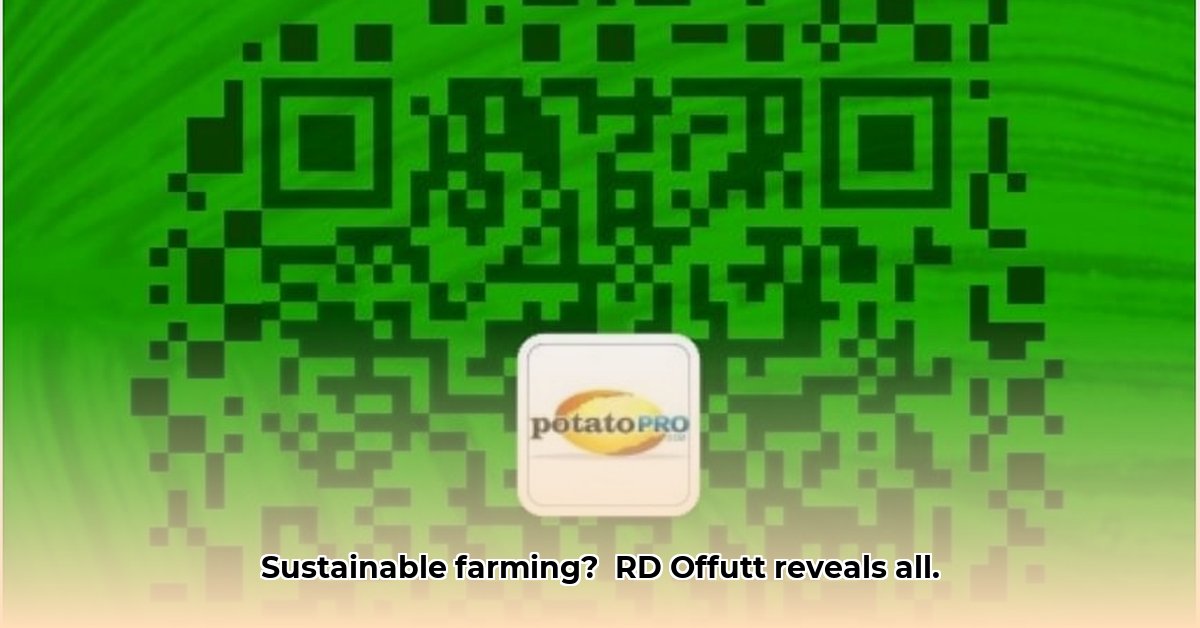
R.D. Offutt Company, the largest potato producer in the United States, cultivates over 50,000 acres, making it a compelling case study in the complexities of sustainable agriculture. This analysis explores their sustainability model, examining both their commendable efforts and the challenges they face in balancing large-scale production with environmental responsibility. The scale of their operation highlights the inherent tension between maximizing food production and preserving natural resources.
A Look at R.D. Offutt's Sustainable Initiatives
R.D. Offutt employs several sustainable farming practices aimed at maintaining soil health and optimizing water use. Their commitment to soil health involves techniques designed to enhance water retention and fertility, essentially providing the land with a "vitamin boost" to ensure long-term productivity. This includes methods such as cover cropping and no-till farming. Further demonstrating environmental stewardship, they've implemented initiatives to create habitats for pollinators, acknowledging the crucial role these insects play in crop production.
The company's collaboration with universities in Minnesota and North Dakota provides access to cutting-edge research, facilitating the development of improved farming techniques. This engagement exemplifies a proactive approach to sustainability, leveraging external expertise to enhance their practices. Their participation in the Potato Sustainability Alliance (PSA) further underscores this commitment to industry-wide improvement, extending beyond their own operations to advocate for broader sustainable practices within the potato farming sector. How effective are these collaborations in achieving real-world improvements? The answer requires continued monitoring and evaluation of the long-term impacts of these combined efforts.
Challenges and Controversies: Balancing Growth and Environmental Impact
Despite R.D. Offutt's demonstrable commitment to sustainability, concerns remain, particularly regarding water usage. The lack of publicly available, detailed data on water consumption hinders a comprehensive assessment of their environmental impact. This opacity fuels concerns, especially surrounding a proposed expansion near the headwaters of the Mississippi River. This expansion plan triggered significant debate, with critics expressing apprehension about potential negative consequences for groundwater and the overall health of the river ecosystem. The situation highlights a common dilemma in large-scale agriculture: the need to balance increased food production with the responsible management of natural resources. Does R.D. Offutt's success come at an environmental cost? Further investigation and transparent data disclosure are essential to address this question. What specific data points could clarify the extent of water usage and its impact on surrounding ecosystems?
Innovation and Collaboration: Shaping the Future of Potato Farming
R.D. Offutt's partnerships with universities have yielded tangible results, including the development of new potato varieties like the Dakota Russet. These new cultivars potentially offer improved yields while minimizing environmental impact. However, a thorough assessment of their long-term sustainability requires ongoing monitoring and evaluation to fully understand their effects. The inherent complexities of agricultural innovations underscore the need for continuous research and adaptation. What additional research is needed to fully assess the long-term environmental and economic impacts of these new potato varieties?
Actionable Steps and Recommendations
Addressing the challenges facing R.D. Offutt and the larger potato farming industry necessitates a collaborative effort. The following actions are crucial for achieving a more sustainable future:
R.D. Offutt Company: Publish detailed water usage data; adopt advanced water management systems; facilitate open communication with the public regarding their environmental practices. Target: Achieve 15% reduction in water usage within the next five years.
Government Agencies: Conduct thorough environmental impact assessments; establish incentives for sustainable farming practices; significantly increase research funding on sustainable agriculture solutions. Target: Enact new regulations governing water use in agriculture by 2026.
Consumers: Demand transparency from food producers; actively purchase sustainably produced goods; advocate for stronger environmental regulations. Target: Increase consumer demand for sustainably grown potatoes by 20% within three years.
Research Institutions: Continue collaborative research projects, focusing on developing sustainable farming solutions; ensure open dissemination of research findings to inform policy and practice. Target: Publish at least five peer-reviewed articles on sustainable potato farming annually.
Assessing the Risks: A Balanced View
A comprehensive risk assessment is crucial for informed decision-making:
| Risk Category | Probability | Impact | Mitigation Strategy |
|---|---|---|---|
| Groundwater Contamination | Medium | High | Regular water quality testing; advanced irrigation methods; transparent reporting of any potential contamination events; prompt remediation. |
| Regulatory Scrutiny | Medium | Medium | Proactive engagement with regulatory agencies; full compliance with environmental laws; clear communication with stakeholders. |
| Reputational Damage | Low | High | Strong commitment to sustainability; public transparency; effective crisis management procedures. |
| Water Scarcity | High | High | Advanced irrigation techniques; development of drought-resistant varieties; conservation practices; water recycling systems. |
R.D. Offutt's journey towards sustainable potato farming is ongoing. While their initiatives demonstrate a commitment to responsible practices, the unresolved concerns surrounding water usage and expansion underscore the need for enhanced transparency and continuous improvement. A balanced perspective, acknowledging both achievements and challenges, is critical for navigating the complex interplay between food production and environmental stewardship. Only through a collaborative and data-driven approach can the industry achieve true sustainability.